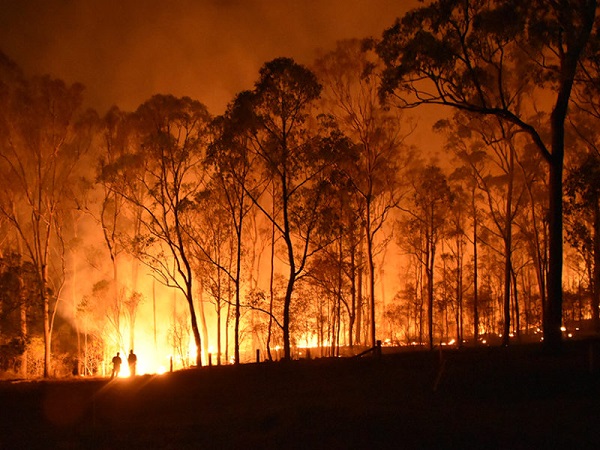
Michael Mann, famous climate scientist, happens to have come to Sydney to study the links between extreme weather and climate change. He tells us Australia, your country is burning – dangerous climate change is here with you now. He took his family to see the Great Barrier Reef while it is still there, and then up into the Blue Mountains, where all they could see was smoke.
He says:
The brown skies I observed in the Blue Mountains this week are a product of human-caused climate change. Take record heat, combine it with unprecedented drought in already dry regions and you get unprecedented bushfires like the ones engulfing the Blue Mountains and spreading across the continent. It’s not complicated.
2019 will always be known for the fires. So how different was the climate?
We now have BOM’s Annual climate statement 2019.
2019 was Australia’s driest year on record with nationally-averaged rainfall 40% below average for the year at 277.6 mm.
2019 was Australia’s warmest year on record. Australia’s area-averaged mean temperature for 2019 was 1.52 °C above the 1961–1990 average, well above the old record: +1.33 °C in 2013. Mean maximum temperatures were the warmest on record at 2.09 °C above average, also well above the previous record, which was +1.59 °C in 2013.
Please note the temperature is referenced against the 1960-1990 average, not pre-industrial.
At 277.6 mm, 2019 rainfall was well below the previous record from 1902 which was 314.5 mm.
The main influence was a very strong positive Indian Ocean Dipole (IOD), one of the strongest on record. The El Niño–Southern Oscillation remained neutral throughout 2019, so I guess things could have been worse.
All this gave us severe fire weather throughout the year; the national annual accumulated Forest Fire Danger Index was the highest since 1950, when national records began.
For images to illustrate, I’ll begin with a temperature trend for the summer months worked out by Tamino:

Looking at the graph, add about 0.5°C to get the anomaly to pre-industrial. This year looks so much an outlier that one would think it unlikely to be repeated for a few years. However, it has shown us what the future may hold.
Here are the maximum temperature deciles:

More than half the continent was the hottest on record, with average and below average bits hard to find.
Here are the rainfall deciles:

The map shows the imprint of the heavy tropical rain and flooding around Townsville, followed by Cyclone Trevor further inland. Nevertheless, every month was below the national average:

The annual bar chart going back to 1900 shows how exceptional 2019 was:

One would expect a better year for 2020, but who knows what the future pattern will be?
However, we have been warned. The BOM report gives the global temperatures for 2019 as the second highest ever:

We’ve had an El Niño contributing to warmth in four out of the last 10 years, including the record 2016. Ominously, El Niño was absent in 2017, 2018 and 2019.
Climate scientist Frank Jotzo has suggested that the bushfire crisis has given the Government a political opportunity to change its policy ambition on climate:
Under climate change, the conditions for catastrophic fires will likely be much more frequent — along with the conditions for drought, flooding and storms.
So a nation-building effort to minimise risk would seem prudent.
Morrison is hiding behind the notion that solving climate change requires effort from all nations. His rhetoric is that Labor’s policy would be “economy wrecking”. Yet leading climate scientists, such as Johan Rockström from the Potsdam Institute say:
“Earth observations show that big systems with known tipping points are already now, at 1°C warming, on the move toward potentially irreversible change, such as accelerated melting of Greenland and West Antarctic ice sheets, drying of rainforests, and thawing of Arctic permafrost”
If we don’t act now, then when?
And in terms of the economy John Quiggin estimates the cost of the fires to be north of $100 billion.
Countries are being asked to come to the 2020 meeting of the UNFCCC Conference of Parties with increased ambition. As preparation the Climate Change Authority published a consultation paper in July, and having heard what came out of the Madrid Conference in December will shortly finalise their advice.
PM Scott Morrison could take that opportunity to show some leadership. Also he has spoken of the possibility of a royal commission on the bushfires. That could be an opportunity to pivot. However, George Megalogenis in Morrison, the political animal who missed the political opportunity to lead thinks Morrison has fluffed it, and simply does not know how to behave faced with an international pile-on.
Ben Jenkins in The people in power will let your country burn says it’s about money, politics and ideology:
this isn’t about people, it’s about ideology, and to accept the unprecedented scale of the fires and act accordingly is to accept that the climate is changing and something needs to be done. That’s it. To me, this is the most striking aspect of the crisis — the debate about how best to douse a burning country has been seamlessly press-ganged into service in the ongoing culture war, all of which is amplified and buttressed by an increasingly demented right-wing media and an absurdly powerful fossil fuels lobby.
Finally:
No one is being told to calm down anymore. The smug reassurances have given way to blind panic as it comes apparent that not even the friendly media can shield the government from the rising ire of the public. But even as the army is called in to assist in the relief effort, even as Morrison agrees to pay volunteer firefighters, even as a two billion dollar recovery fund is pledged, the government refuses to alter its climate change policy.
